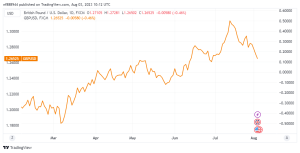GBPUSD fell below 1.2700 for the first time in over a month.
GBPUSD finished in negative territory on Wednesday and continued its weekly decline early Thursday. Reaching a low below 1.2700 for the first time since early July. The Bank of England (BoE) will publish monetary policy decisions at 11:00 GMT. And BoE Governor Andrew Bailey will give a news conference beginning at 11:30 GMT to discuss the policy outlook.
Following its August meeting, the Bank of England is largely expected to raise its policy rate by 25 basis points to 5.25%. Such a move may not be sufficient to start a Pound rebound on its own. Despite signs of lessening pricing pressure, the Bank of England must reassure investors. That it will continue to tighten policy. Furthermore, if the policy announcement discloses that several policymakers voted in favor of a 50 basis point raise, the Pound Sterling might strengthen.
The Bank of England is projected to increase its policy rate by 25 basis points to 5.25%.
If the Bank of England shocks markets by raising interest rates by 50 basis points. GBPUSD is expected to jump in response. However, in that situation. The BoE might herald the end of the tightening cycle, restricting the pair’s potential gains.
A 25 basis point boost by the Bank of England, combined with a dovish statement acknowledging slower inflation and a lack of impetus in economic development, on the other hand, might cause a new leg lower in GBPUSD.
The US Dollar is still being supported by safe-haven flows.
The US On Thursday, the economic calendar will include weekly Initial Jobless Claims and ISM Services PMI statistics. A weekly Jobless Claims report of 200K might help the USD maintain its momentum. Investors will also pay particular attention to the ISM Services PMI survey’s Employment Index. A score below 50 would indicate a decline in service employment and would weigh on the USD ahead of Friday’s crucial Nonfarm Payrolls data.
GBPUSD Technical Outlook
The next level of support for the GBPUSD is 1.2650 (a static level from July). The lower-limit of the falling regression channel reinforces this level.
It’s also worth noting that the four-hour chart’s Relative Strength Index (RSI) indicator remains slightly below 30, indicating oversold circumstances.
Nonetheless, investors may disregard technical circumstances. If the Bank of England makes a dovish decision, Sterling will face selling pressure. Below 1.2650, 1.2600 (psychological level, static level) aligns as the next support level before 1.2550 (June static level).

On the upside, 1.2700 (the descending channel’s midpoint, psychological level) serves as the initial resistance level, followed by 1.2750 (the static level) and 1.2780 (20-period Simple Moving Average (SMA), the upper-limit of the descending channel).









